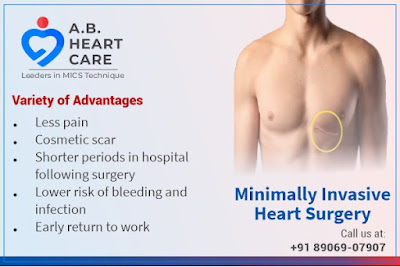There are only a few cases of minimally invasive cardiac surgery. It's also known as Coronary Artery Surgery with Limited Access or Keyhole surgery. Two of the techniques offered are Port-Access Coronary Artery Bypass (PACAB or Port CAB) and Minimally Invasive Coronary Artery Bypass Graft (MIDCAB). Dr. Ashwani Bansal, Chandigarh's Best Cardiac Surgeon, can assist you with any procedure.
It’s a less invasive alternative to traditional bypass surgery (CABG). In the chest, small incisions (ports) are made. To “bypass” the obstructed coronary artery or arteries, chest arteries or veins from your leg are connected to the heart. The bypasses are performed by passing the instruments through the ports. The procedure is carried out while the heart continues to beat. After the procedure, the patient will need to stay in the hospital for a few days. When compared to traditional bypass surgery, it takes less time to recuperate (CABG).
Also see: cardiologist in Chandigarh
A shift toward minimally invasive (MI) procedures has been one of the most significant breakthroughs in surgery during the last few decades. The concomitant reduction in trauma to the patient from smaller incisions has prompted this shift in practise, resulting in shorter hospital stays and recuperation durations. The lack of visibility to the world being operated on is one of the major challenges of minimally invasive cardiac surgery (MICS).
Despite the fact that imaging scopes are developing all the time, none have been able to combine angiographic picture capabilities with high-definition white light until now The PINPOINT Endoscopic Fluorescence Imaging System might be used in the same way as other endoscopes used in today’s laparoscopic operations. PINPOINT allows surgeons doing minimally invasive treatments to see blood flow in vessels and tissue perfusion in real-time while in the operating room, in addition to the typical images obtained with a standard endoscope.
PINPOINT also gives surgeons the option of seeing images in a “overlay” mode, which combines visible and fluorescent imaging. The overlay model gives surgeons the best of both worlds by allowing them to see both anatomical features and physiologic information in a single image. The overlay mode can be used as a surgical map, allowing the surgeon to see leaks clearly while keeping an eye on anatomical alignment. PINPOINT can equip surgeons by giving therapeutically important anatomic and physiologic information in real-time.
performing minimally invasive cardiac surgery with the data they need to make key operating room choices PINPOINT has been linked to lower incidence of potentially costly post-operative complications and increased surgeon confidence in doing MIS operations.
Advantages of Minimally invasive cardiac surgery
Increased safety: a little incision results in less physical damage and significantly less blood loss.
Reduced scarring: most incisions only require one or two stitches to close.
Faster recovery: whereas standard surgery takes six to eight weeks to recover from, patients who have undergone minimally invasive cardiac surgery commonly recover in within a fortnight.
Reduced hospital stay: Most MICS treatments result in a 23-hour discharge or outpatient surgical appointment.
Related links:












0 Comments